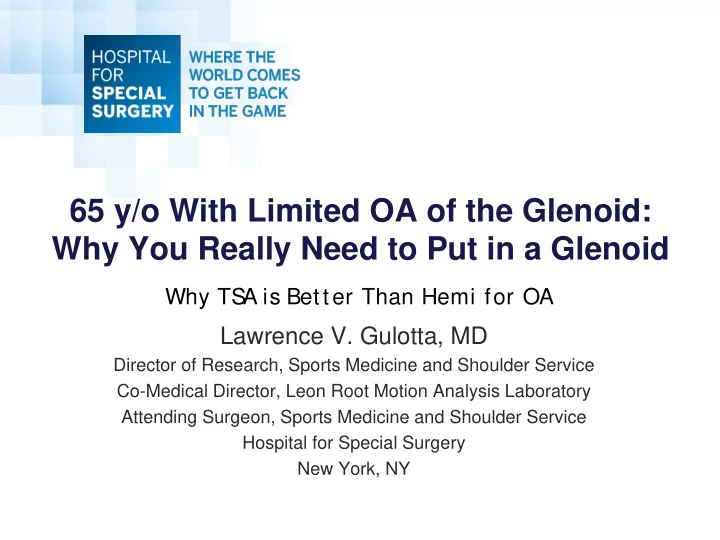

65 y/o With Limited OA of the Glenoid: Why You Really Need to Put in a Glenoid Why TS A is Better Than Hemi for OA Lawrence V. Gulotta, MD Director of Research, Sports Medicine and Shoulder Service Co-Medical Director, Leon Root Motion Analysis Laboratory Attending Surgeon, Sports Medicine and Shoulder Service Hospital for Special Surgery New York, NY
Disclosures Zimmer-Biomet, Inc – Speaking and Consulting
Perspective • Change the scenario: • 65 y/o male with groin pain: “ Let’s do a hip hemiarthroplasty” -said no arthroplasty surgeon in the last 20 years
Perspective • 65 y/o with enough OA to justify shoulder arthroplasty, but with “limited OA of the glenoid”.
Utilization of Hemiarthroplasty • Kim et al. JBJS 2011
Utilization of Hemiarthroplasty 2011 United S tates - 66,485 S houlder Arthroplasties - 44% TS A - 38% RS A - 23% Hemi
Why Hemiarthroplasty • Hemi attractive due to: • Don’t have to expose the glenoid • Technically easier • Shorter OR time • Encouraging short term data • No fear of eventual glenoid loosening • Especially in young, active patients • Lower surgical costs
Hemiarthroplasty – Encouraging Short Term Despite Promising S hort Term Clinical Results All S tudies S how Glenoid Erosion
Hemiarthroplasty – Encouraging Short Term • 38 Shoulders • All had glenoid erosions • F/U 65.4 months • Revision 37% for painful glenoid erosion No Fear of Glenoid Loosening Just Fear of Glenoid Erosion
Hemiarthroplasty – Encouraging Short Term 1997 - 74% with S atisfactory Results - 86% S atisfactory when Glenoid Wear Concentric - 63% S atisfacdtory when Eccentric Wear
Hemiarthroplasty – Encouraging Short Term “ On the basis of these results hemiarthroplasty can be an effective treatment for both primary and secondary arthritis but should be reserved for patients with a concentric glenoid which affords a better fulcrum for glenohumeral motion”
Hemiarthroplasty – Encouraging Short Term, but… • 31 Shoulders • 25% Satisfied • F/U 17.2 years • 26% Revision Rate • Concentric did better than eccentric • But both deteriorated over time.
Hemiarthroplasty – Encouraging Short Term, but… “ Patients with concentric glenoid wear and primary osteoarthritis have better outcomes • 31 Shoulders • 25% Satisfied than those with eccentric glenoid wear and • F/U 17.2 years • 26% Revision Rate secondary osteoarthritis do, but patients in • Concentric did better than both groups experienced deterioration of eccentric results over time” • But both deteriorated over time.
What About Glenoid Survival with TSA? JBJS , 2014 • Glenoid loosening • 63 TSA’s worsens with time • Very durable for 10 years
What About Glenoid Survival with TSA? JS ES , 2013 • 151 TSA’s • Humerus seldom loose (3%) • Radiographic glenoid • Clinical glenoid failure rare loosening common
What About Glenoid Survival with TSA? JS ES , 2013 • 151 TSA’s • Humerus seldom loose (3%) • Radiographic glenoid • Clinical glenoid failure rare loosening common • Factors associated with • Importance of meticulous glenoid glenoid loosening preparation • Radiolucent lines at time zero (OR 4.6) • Poor glenoid seating at time of surgery
What About Glenoid Survival with TSA? JS ES , 2009 • 125 TSA’s • End-point revision • All-poly glenoids outperform • All Glenoids metal-backed
Glenoid Survival – Related to Humeral Position JS ES , 2013 • Poorly implanted humeral • 52 TSA’s component led to glenoid • All under 55 years old loosening
What Does All This Data Tell Us? • Glenoid is the weak link • It requires meticulous preparation and implantation • Humeral position is important too because malposition starts a chain reaction that leads to glenoid loosening. • Cuff failure • Rocking horse • Glenoid failure S urgical Technique Directly Relates to Long Term Outcomes Can Be Difficult, But Worth Putting In
Hemiarthroplasty vs TSA • 23 Studies, mean f/u 43 • Revisions: months •HHR 10.2% • Better outcomes in TSR •TSR 6.5% compared to HHR • All poly glenoid = 1.7% •Pain relief •ROM •Pt Satisfaction
Hemiarthroplasty vs TSA
Hemiarthroplasty vs TSA Hemi TS A 20% of hemi ’ s were converted to TSA
Hemiarthroplasty vs TSA – Young Patients • Sperling et al, JBJS 1998 • Patients under 50y/o • Neer hemi and Neer TSA • TSA starts to separate at 10 Years Over time – more likely to have revision to put in a glenoid for failed hemi, than to revise a glenoid for failed TS A
Hemiarthroplasty vs TSA – Active Patients • Garcia et al. AJSM, 2016 (HSS) • 40 Hemi vs 40 TSA, matched • F/U of 62 months • Patients with TSA had: • Better Pain Relief (VAS 0.6 vs 2.2) • More satisfaction (100% vs 70%) • Better return to sports (97.3% vs 65.5%) Reality is that patients are better able to return to sports after TS A vs Hemi
What About Cost? • When considering a higher revision rate for hemiarthroplasty compared to TSA, TSA is more cost- effective, even in young patients.
Hemiarthroplasty vs TSA
Conclusions • TSA outperforms Hemi for OA – that’s a fact • However, glenoid is weak link in TSA • While radiographic failure is common, clinical failure is rare • Your surgical technique matters and it affects long term outcomes • Know how to see and prepare the glenoid • Appreciate glenoid morphology and know how to correct deformity • Meticulous bone preparation and cement technique • Cemented, all-polyethylene pegged or keeled glenoids are standard of care. • Anatomic humeral restoration is critical • Provides concentric articulation • Limits cuff failure, which can lead to glenoid loosening • While technically challenging, putting in a glenoid is worth the effort
Thank You
Recommend
More recommend